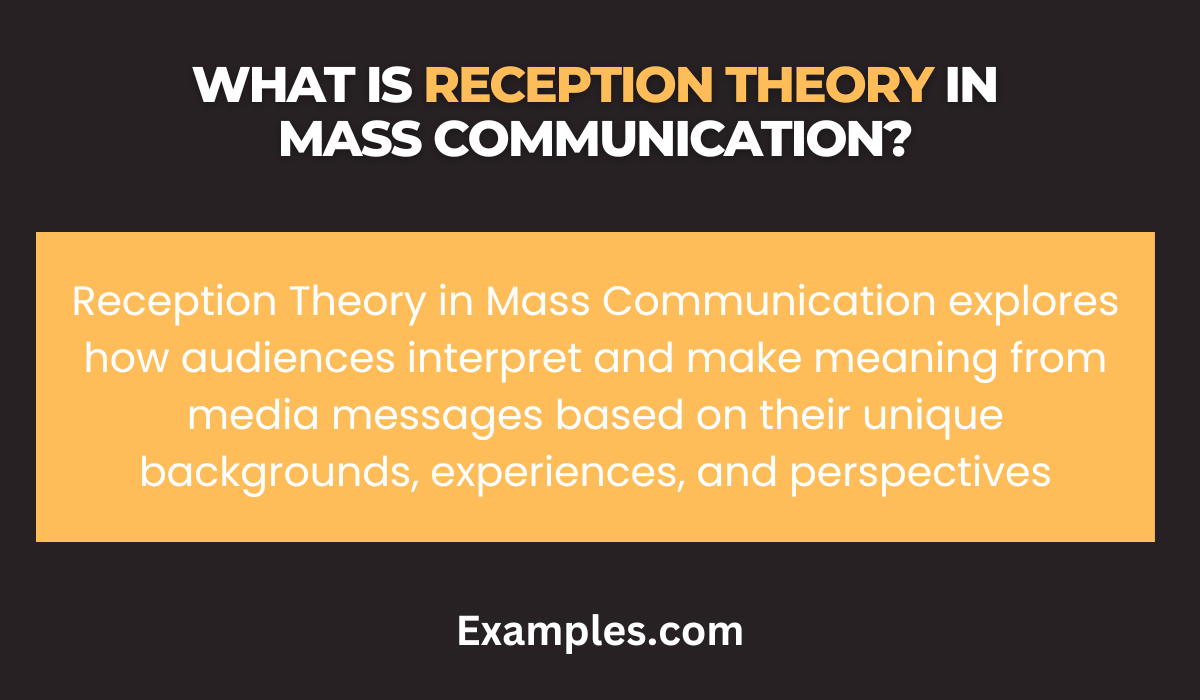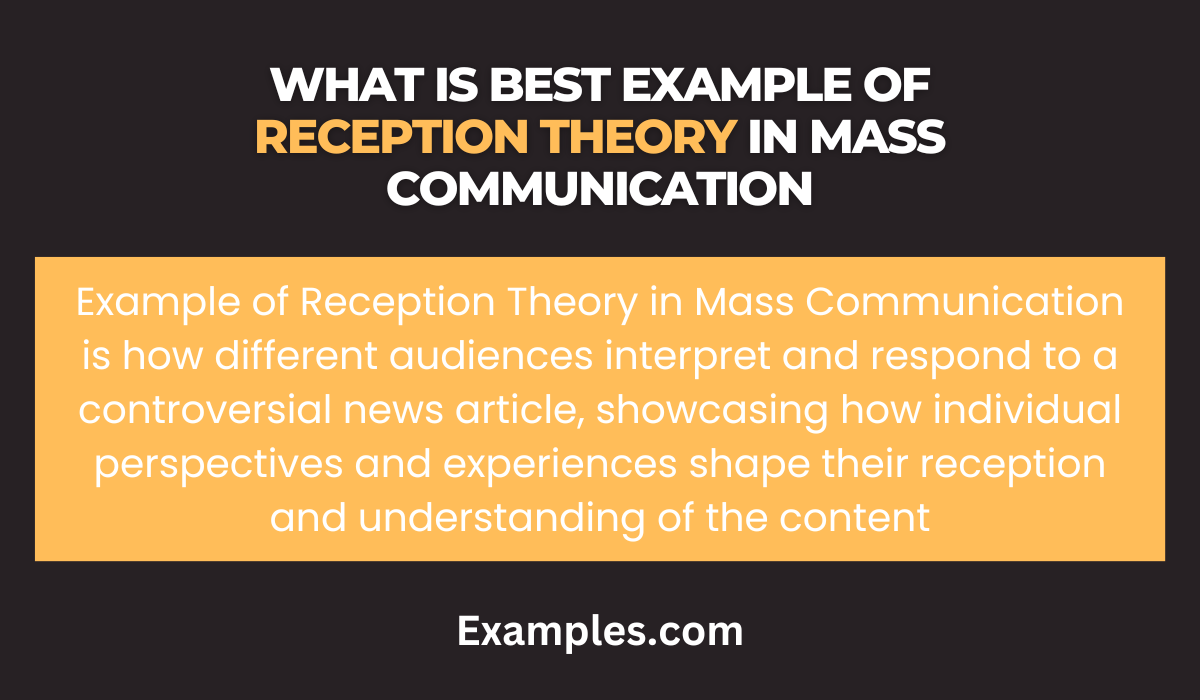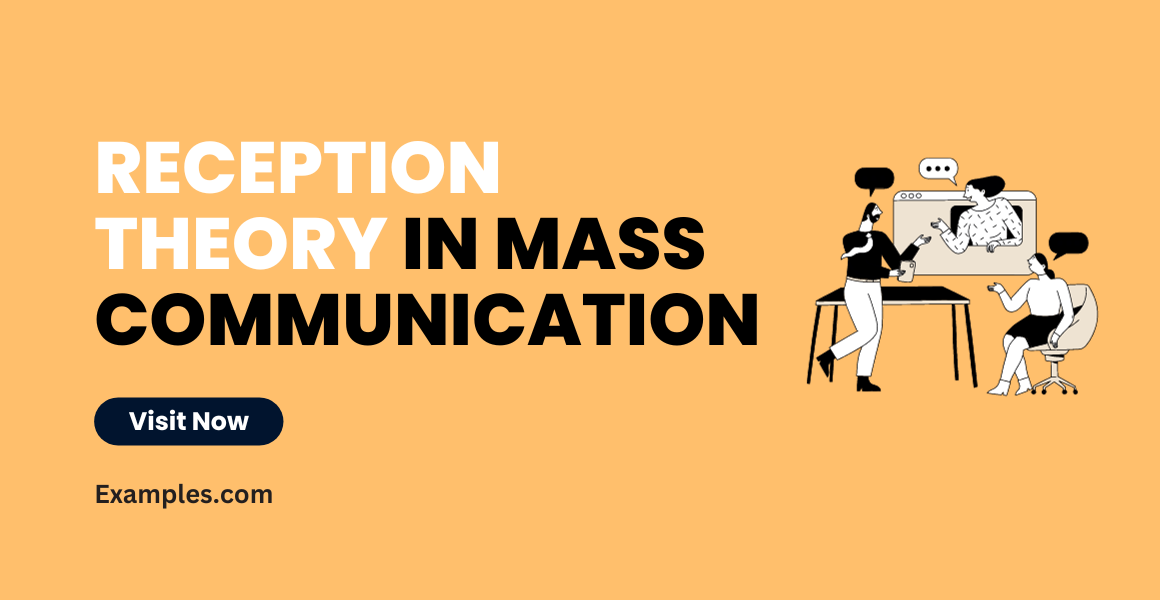29+ Reception Theory in Mass Communication Examples
Reception Theory in Mass Communication plays a pivotal role in understanding how audiences interact with media messages. This comprehensive guide delves into the intricate dynamics of how people receive and interpret information in Mass Communication. From exploring various Mass Communication Examples to understanding its profound impact in different scenarios, this guide offers insightful perspectives. Whether it’s in journalism, social media, or advertising, the theory’s application is vast, making it a crucial aspect of Mass Communication in Real Life. This guide not only enlightens readers about the theory’s fundamentals but also provides practical examples, making it an essential resource for anyone interested in the field of Mass Communication.
What is Reception Theory in Mass Communication?
Reception Theory in mass communication is a framework that explores how audiences interact with media texts and derive meaning from them. It emphasizes that the meaning of a media message is not solely determined by the content itself but is also shaped by the audience’s social background, beliefs, and experiences. This theory stands out in the landscape of Mass Communication Theories, challenging the notion that media impacts all viewers uniformly.
Unlike other theories that focus on how media content affects the audience, Reception Theory delves into the varied interpretations and understandings that different audience members have. It acknowledges that individuals consume media differently based on factors like cultural background, personal experiences, and societal influences. This perspective shifts the focus from a sender-oriented communication model to one that gives significant weight to the receiver’s role.

History of Reception Theory in Mass Communication
Reception Theory in mass communication is a critical perspective that focuses on how audiences interact with media texts to create meaning. This theory emerged in the late 20th century, challenging traditional notions that viewed audiences as passive receivers of media messages. Instead, Reception Theory posits that audiences are active participants who interpret media based on their personal, social, and cultural backgrounds.
Key to understanding Reception Theory is its departure from earlier mass communication models like the Hypodermic Needle Theory and the Two-Step Flow Theory. These models suggested a direct, powerful impact of media messages on a passive audience. Reception Theory, however, brought a paradigm shift by emphasizing the active role of the audience in interpreting messages.
One of the main functions of mass communication, as seen through Reception Theory, is not just to disseminate information but to provide a framework within which people can create their own meanings. This perspective aligns closely with the Encoding/Decoding Model proposed by Stuart Hall, which highlights how media texts are encoded with meaning by producers and decoded by audiences in various ways.
The significance of Reception Theory in today’s digital age is profound, especially with the advent of social media and Mass Personal Communication. It allows for a more nuanced understanding of how different audiences might interpret the same message in diverse ways. This understanding is crucial for professionals in journalism, public relations, and advertising, as it impacts how they craft their messages for varied audiences.
What is Best Example of Reception Theory in Mass Communication?
A classic example of Reception Theory in action can be observed in the analysis of news broadcasts. Consider the coverage of a significant political event. The way viewers interpret and respond to the news depends on their political beliefs, cultural background, and personal experiences. For instance, supporters of a political party may perceive the coverage as biased or fair depending on their pre-existing views.
Another illustrative example involves Television Mass Communication. Different audiences might interpret the same TV show in various ways. For example, a comedy series may be seen as a light-hearted entertainment by some, while others might find deeper social commentary in its humor. This divergence in interpretation highlights how personal contexts and experiences shape the way media content is received and understood.
In both examples, the key takeaway of Reception Theory is evident: the audience plays a crucial role in constructing the meaning of media messages. This theory underscores the complexity of mass communication and the importance of considering diverse audience perspectives in understanding media effects.

30 Examples of Reception Theory in Mass Communication
Reception Theory in mass communication explores how audiences interact with media messages, focusing on the varied interpretations and meanings individuals derive. This approach underscores the active role of the audience in decoding messages, influenced by their cultural background, social context, and personal experiences. Here are 30 unique examples demonstrating this concept

- Watching a Political Debate: Viewers interpret the debate based on their political leanings. A conservative might perceive a liberal candidate’s arguments as unpersuasive, while a liberal viewer may find them compelling.
- Social Media Campaigns: Different age groups interpret social media campaigns uniquely. Millennials might see a campaign as innovative, whereas older generations could find it confusing.
- News Reports on Climate Change: Environmentalists may see urgency in a report, while skeptics might question its credibility.
- Movie Reviews: A film critic’s background influences their review. A critic with a love for sci-fi may rate a science fiction movie highly, while a critic favoring dramas might not.
- Health Communication: People with medical knowledge perceive health messages more critically than those without.
- Advertising in Sports: Sports fans might see a sports drink ad as motivational, while non-fans could view it as just another product.
- Educational Broadcasting: Students might find educational programs engaging or dull, based on their interest in the subject.
- Public Relations Campaigns: The effectiveness of PR messages can vary based on public trust in the organization.
- Journalistic Bias: Audiences may perceive bias in news reporting based on their own beliefs and experiences.
- Fashion Blogging: Readers might see a fashion blog as trendsetting or unrelatable, depending on their personal style.
- Music Videos: Generational gaps can lead to different interpretations of a music video’s message.
- Celebrity Interviews: Fans often interpret celebrity statements positively, while critics may be skeptical.
- Radio Talk Shows: Listener’s personal values influence their reception of the content.
- Documentary Films: Viewers might find documentaries either enlightening or biased.
- Book Reviews: A reader’s background influences their interpretation of a book review.
- Email Newsletters: The perceived value of content in newsletters can vary widely among subscribers.
- TV Sitcoms: Cultural background plays a significant role in how humor is received in sitcoms.
- Online Tutorials: Learners with different skill levels interpret the usefulness of tutorials differently.
- Podcasts on Current Affairs: Political orientation influences how listeners interpret these podcasts.
- Street Billboards: The impact of a billboard ad can vary based on the viewer’s interests.
- Fashion Magazines: Personal taste in fashion affects how readers perceive magazine content.
- Tech Product Reviews: Tech-savvy readers might find reviews more insightful than those less knowledgeable in the field.
- Travel Blogs: Readers’ travel experiences influence how they perceive a travel blog’s advice.
- Children’s TV Programs: Parents and children may have different views on the value of the content.
- Art Exhibitions: Personal taste in art affects the reception of an art exhibition.
- Movie Trailers: Expectations based on trailers can differ widely among potential viewers.
- Radio Music Charts: Listeners’ music preferences influence how they perceive the popularity of songs.
- Health and Fitness Blogs: Readers’ health consciousness affects how they interpret blog advice.
- Political Cartoons: Viewer’s political beliefs skew their interpretation of political cartoons.
- Economic News: People with different economic backgrounds perceive the relevance of economic news differently.
Role of Reception Theory in Mass Communication
Reception Theory in mass communication plays a pivotal role in understanding how audiences interact with media content. This theory diverges from traditional perspectives that focus on the sender or the message, instead emphasizing the receiver’s role in interpreting media messages. Here, we delve into the key functions of reception theory in the realm of mass communication.
- Interpreting Media Messages: Reception theory highlights how different audiences may interpret the same media message in various ways. This variance is influenced by individual backgrounds, cultural contexts, and personal experiences.
- Audience Empowerment: It empowers audiences by acknowledging their active role in making meaning from media messages, rather than being passive recipients. This aspect is particularly relevant in Mass Personal Communication where individual interpretation plays a significant role.
- Cultural and Social Influence: Reception theory examines how media consumption is shaped by cultural and social factors. It underscores the idea that individuals’ understanding of media content is deeply rooted in their societal context, reflecting broader patterns in Mass Communication in Real Life.
- Critical Analysis of Media: This theory encourages critical thinking about media content. Audiences are seen as critical analyzers who decode messages based on their ideological and cultural perspectives.
- Feedback Mechanism: In mass communication scenarios, reception theory facilitates a feedback loop where audiences can respond to media messages, influencing future media production. This aspect is crucial in Social media Mass Communication, where audience feedback is immediate and visible.
- Shaping Public Opinion: Reception theory plays a crucial role in understanding how public opinion is formed and influenced through mass media. It acknowledges that individuals interpret news and information based on their predispositions, which can significantly shape their views and opinions.
- Media Strategies: For practitioners in Journalism Mass Communication, understanding audience reception is vital for tailoring content to meet audience needs and preferences. It guides media professionals in creating more engaging and relevant content.
- Reshaping Media Policies: Insights from reception theory can inform media policies and regulations by highlighting the need for diverse and inclusive content that caters to different audience interpretations.
- Adapting to Technological Changes: With the advent of digital media, reception theory helps in understanding how new technologies like Blog Mass Communication or Television Mass Communication are changing the way audiences interact with media.
- Educational Applications: In educational settings, particularly in Mass Communication Examples in School, reception theory can be used to teach students about media literacy and critical thinking in interpreting media messages
Importance of Reception Theory in Mass Communication
The importance of Reception Theory in Mass Communication cannot be overstated. It has revolutionized our understanding of media audiences and has significant implications for media producers and marketers. Key points include:
- Audience Empowerment: It empowers audiences, acknowledging their ability to critically engage with and interpret media messages.
- Cultural Context: Reception Theory highlights the importance of cultural context in shaping media interpretations, leading to a more nuanced understanding of global media consumption patterns.
- Media Strategy Development: It aids media strategists and content creators in crafting messages that resonate with diverse audience groups.
- Understanding Audience Diversity: The theory is crucial for understanding the diversity within audiences, paving the way for more inclusive and representative media content.
- Enhanced Media Literacy: It contributes to enhanced media literacy, encouraging audiences to be more questioning and critical of media messages.
How to use Reception Theory in Mass Communication
Applying Reception Theory in Mass Communication involves several strategies that media professionals can use to better engage with their audiences:
- Audience Research: Conducting in-depth audience research to understand the diverse interpretations and reactions to media content.
- Tailored Content Creation: Creating content that acknowledges and appeals to the diverse interpretations and cultural contexts of the audience.
- Feedback Mechanisms: Implementing feedback mechanisms to gather audience interpretations and use this data to inform future content.
- Cultural Sensitivity: Ensuring cultural sensitivity and awareness in media messages to resonate with a global audience.
- Interactive Platforms: Utilizing interactive platforms and social media to facilitate audience engagement and to understand their perspectives.
- Educational Initiatives: Developing educational initiatives to enhance audience media literacy, enabling them to engage more critically with media content.
Reception Theory offers a dynamic and audience-centric perspective in Mass Communication, highlighting the interactive nature of media consumption. It is instrumental in understanding the complex relationship between media messages and audience interpretations, shaping the way media content is created, distributed, and consumed in our increasingly connected world.



